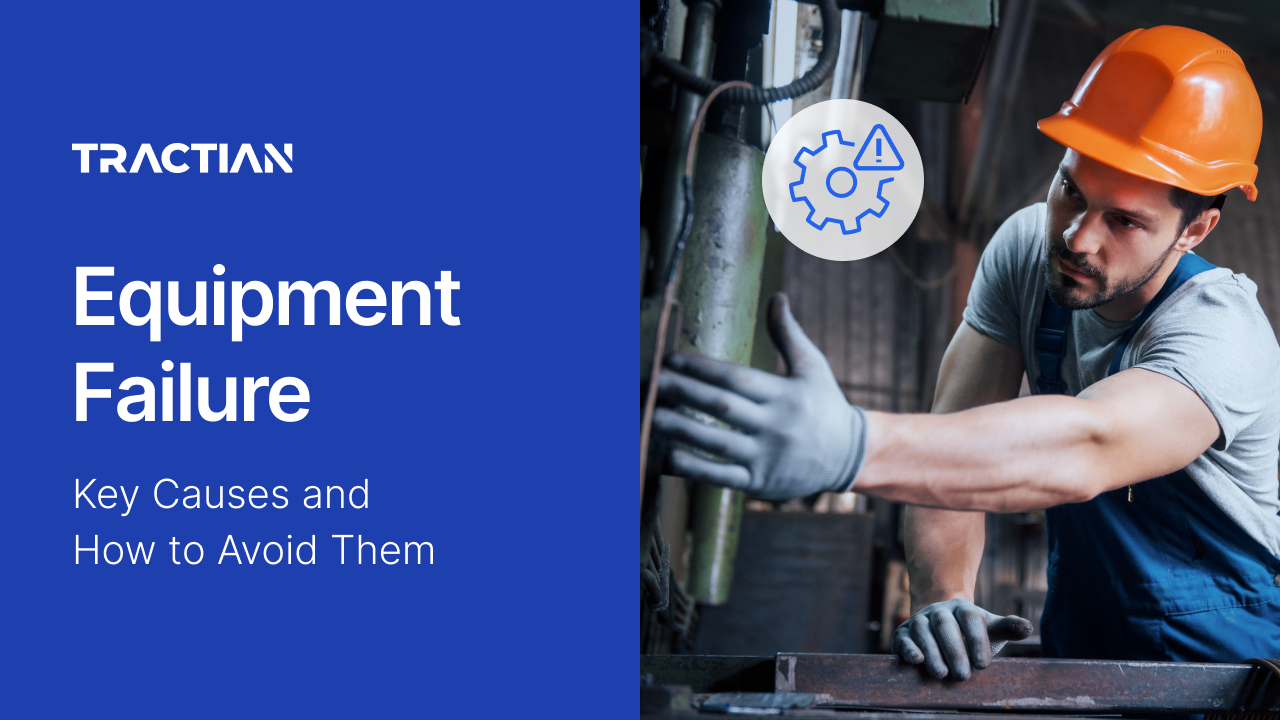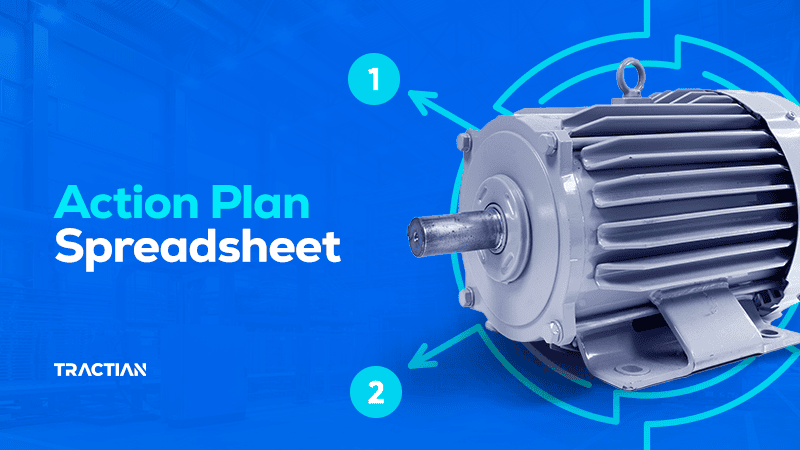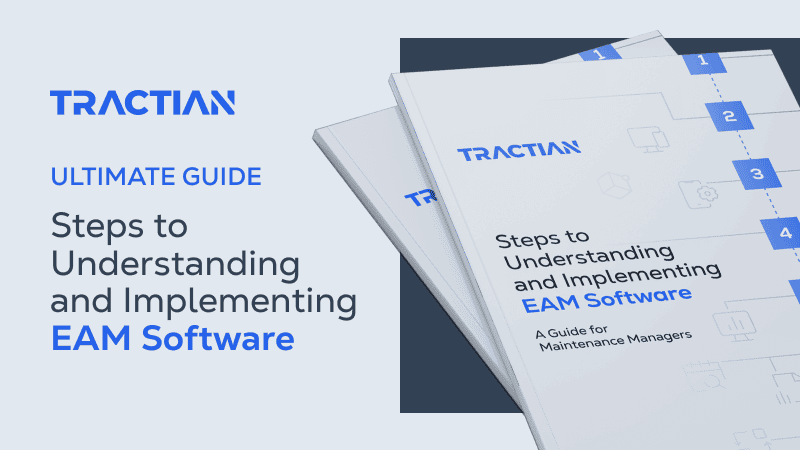There’s no getting around it: When a machine breaks down, production stops. But here’s the thing: most equipment failures don’t just happen suddenly. They build up over time, hidden and unnoticed until it’s too late.
And when reliability is non-negotiable, every unplanned stop matters. Still, many teams find themselves caught off guard, dealing with emergencies that could’ve been avoided with the right strategy.
Understanding what causes equipment failure is the first step toward building a more resilient operation. But it's not just about knowing the theory.
You also need to notice the signs of potential failure in real time, recognizing weak points before they become problems. What’s more, you need to have systems in place that make preventive action second nature.
This guide will show you exactly where to start. From the types of equipment most prone to breakdowns to the hidden causes that lead to costly downtime, we’ll walk through the core reasons why failures happen and how to stop them before they do.
What is Equipment Failure?
Equipment failure happens when a machine or component can’t perform its intended function. You might be looking at a complete shutdown, or maybe just a partial failure.
Either way, the outcome is the same: performance drops and processes stall.
But failure isn't just a mechanical event, it’s also an important signal to pay attention to. Signals like these tell you something has broken down somewhere in your process.
And like clockwork, every failure points back to how that equipment was operated and maintained (or ignored) over time.
From a reliability standpoint, equipment failure is a technical issue and a strategic one. It's not enough to react when things stop working. The real goal is to reduce the likelihood of failure through consistent monitoring, data analysis, and decision-making that prioritizes long-term performance over short-term fixes.
And that shift from reacting to anticipating is what separates facilities that chase uptime from those that actually achieve it.
3 Types of Equipment That Fail
Not all assets are built or used the same way, so naturally, different types of equipment are prone to different types of failure. And if you’re trying to prevent breakdowns, understanding where those specific risks lie is a critical part of the job.
Here are three categories of equipment that consistently show up on failure reports across industrial operations:
1. Rotating Equipment
Motors, pumps, compressors, fans, and gearboxes-anything with moving parts that rely on consistent speed and alignment-are often prone to failure. These machines are high-value, high-dependency assets, but they often fail due to wear, imbalance, poor lubrication, or misalignment.
Because they operate under constant mechanical stress, they’re also ideal candidates for condition monitoring.
2. Electrical Equipment
Things like panels and transformers fall into this category. Failure here usually comes from thermal stress, insulation breakdown, loose connections, or contamination.
Because electrical failures can trigger broader safety and compliance issues, the stakes are particularly high here, making predictive and preventative maintenance a must.
3. Utility and Support Systems
Think chillers, boilers, and HVAC systems.
These assets may run in the background, but their failure creates cascading disruptions like uncontrolled temperature swings and expensive supply chain bottlenecks. Unfortunately, they often exist in a viscious cycle, overlooked until failure hits (which is exactly why they're so prone to it).
The 7 Common Causes of Equipment Failure
If you look hard enough, you’ll see a pattern in every failure. When you trace most failures back to the source, it’s usually one of these seven causes:
1. Aging Equipment
Every piece of equipment has a lifespan. Over time, wear accumulates and systems naturally fall out of spec.
These aging assets become less stress-tolerant and more prone to failure, especially if they've been pushed beyond their design limits or haven’t been properly maintained throughout their lifecycle.
But age alone doesn’t doom a machine. The real issue is when aging equipment is treated as if it's still operating at peak condition. Without condition monitoring or periodic reassessment, degradation sneaks up slowly until a key component gives out.
To keep aging assets from becoming liabilities, teams need clear visibility into performance trends, increased inspection frequency, and, when appropriate, a strategy for planned replacement or refurbishment.
2. Operator Error
The way a machine is operated directly impacts how long it lasts. Things like improper start-up and exceeding load capacities can quickly lead to premature equipment failure.
Most of the time, the problem here stems from a lack of clear procedures and bad habits built up over time. Especially when teams are operating under intense time crunches, these little mistakes slowly build up failure risk over time.
The easiest fix? Building a structure where correct operating procedures are easy to follow and mistakes are flagged before they cause real harm. This could look like updating SOPs, increasing operator check-ins, or using digital systems that link usage history with asset condition.
3. Lack of Preventive Maintenance
Without regular upkeep, small issues escalate into major failures. Corrosion spreads. Filters clog. One missed step creates a chain reaction.
This is where the old debate often comes up: Why not just run equipment until it fails and fix it when it does?
That’s called run-to-failure maintenance-a reactive strategy where repairs only happen post-breakdown. In some cases, it works well, especially for non-critical, low-cost components.
But when applied to high-value assets, it introduces massive risk: longer downtimes, higher repair costs, and a total lack of control over when failure strikes.
Preventive maintenance, on the other hand, introduces a structure that keeps machines operating for longer. Maintenance tasks are scheduled based on time or usage, reducing the chance of failure before it occurs. It's not perfect, though. Some assets might still fail unexpectedly, but it builds a nice buffer into your operations.
4. Over-Maintenance
It sounds counterintuitive, but too much maintenance can be just as damaging as too little.
Over-maintenance typically happens when outdated systems or rigid checklists don’t account for an asset’s actual condition or usage.
If a component is replaced too frequently, for instance, you’re introducing risk where there wasn’t any to begin with. Every touchpoint creates the chance for something to go wrong.
Condition-based maintenance (CBM) and predictive analytics make it possible to shift the focus from frequency to necessity, optimizing interventions based on real-time asset health.
5. Bad (or No) Reliability Culture
Reliability doesn’t come from a single action, it builds over time from a good culture. When that kind of solid foundation is missing, equipment failure becomes a recurring problem.
There are several tell-tale signs of a weak reliability culture: maintenance teams constantly in firefighting mode, planners overwhelmed by backlog, or a leadership team that prioritizes short-term output over long-term stability.
In environments like these, breakdowns are treated as “just part of the job.”
The good news is, these cultural issues are fixable if teams commit. The baseline is figuring out how to align everyone around one shared goal: keeping assets running as intended. If you can start here, that means building cross-functional accountability and creating better workflows becomes much easier.
6. Failure to Continuously Monitor Equipment
Most failures don’t happen out of nowhere. Temperatures creep, pressure shifts, etc. The problem is, if you're not continuously monitoring those parameters, you’ll miss those signs until it’s too late.
Relying solely on manual inspections or scheduled checks creates blind spots, and equipment can quickly degrade in the gaps.
That’s why continuous monitoring with IoT sensors and integrated CMMS software is becoming the new baseline. These technologies make it possible for teams to detect abnormalities faster and fix issues before they cause problems.
7. Inadequate Lubrication
It might sound basic, but poor or improper lubrication is one of the fastest ways to destroy equipment. Too little lubrication creates increased friction and heat. Too much creates drag and attracts contamination.
Plus, the wrong type of lubricant can erode component surfaces or break down under temperature extremes.
Even something as simple as skipping a grease point or over-lubricating a bearing can compromise the entire system.
To prevent this, every lubrication task should be mapped to a clear schedule, and validated during inspections.

How to Prevent Equipment Failure
Knowing what causes failures is only half the job. Learning how to prevent them in a consistent and cost-effective way is where real operational reliability is built.
This doesn’t mean overhauling everything at once. It simply means tightening the connection between people, processes, and technology.
Here’s how to do exactly that:
1. Provide Thorough Operator Training & Maintain Compliance
Operators are the first line of defense when it comes to asset reliability. If they’re not fully trained, the risk of unintentional damage increases significantly.
Training programs shouldn’t stop at onboarding though. Refresher sessions and providing quick access to procedures (especially when changes are made) help keep operational standards high.
Also, as regulatory pressure grows, consistent training also ensures compliance, reducing the risk of safety violations or audit failures.
2. Monitor & Analyze Equipment Digitally
Static maintenance schedules can’t keep up with dynamic production environments. That’s why digital monitoring is essential-not just for tracking real-time performance, but for understanding long-term trends.
Connected sensors and CMMS software lets maintenance teams continuously monitor vibration, temperature, pressure, and other critical indicators.
This is how teams shift from “fixing” to forecasting.
3. Balance Preventive with Condition-Based Maintenance
Preventive maintenance keeps your assets running. But doing on fixed intervals without considering actual wear can lead to over-maintenance or missed failures.
Condition-based maintenance (CBM) fills that gap. It triggers interventions based on real-time data, not just calendar dates or runtime hours. The goal isn’t to replace preventive maintenance, but to optimize it.
4. Attach SOPs to Work Orders
When technicians open a work order, they shouldn’t have to guess what “replace bearing” actually involves. Every task should come with a clear, up-to-date Standard Operating Procedure (SOP).
Embedding SOPs into digital work orders keeps maintenance workflows consistent across teams, and reduces onboarding time for new technicians.
5. Run Routine Maintenance Inspections
Routine inspections are your eyes and ears on the shop floor. They don’t have to be complex.Simple visual checks, noise observations, or thermal scans can reveal potential issues early.
The key is consistency. Random inspections catch little. Scheduled, structured walkdowns give technicians a baseline for spotting deviations. And when those findings are logged in a CMMS, they help build an equipment history that informs future decisions.
6. Implement Preventive Maintenance Strategies
Preventive maintenance is a foundational strategy, and for good reason. It standardizes tasks before failure occurs. But to be effective, it must be customized to asset criticality, usage patterns, and failure history.
That’s where asset data plays a key role. Teams that analyze this data can structure PM plans that match the real-world needs of their operation, not just OEM guidelines.
Why Root Cause Analysis Matters in Preventing Failures
Fixing a broken part is one thing. Understanding why it failed in the first place is where the real magic happens.
Root Cause Analysis (RCA) is the process of tracing a failure back to its origin. It doesn't just treat the symptom, but identifies the actual trigger behind it. Skipping this step is what keeps teams stuck in the same cycle of recurring breakdowns.
Every failure can be traced back to a root cause: misalignment, poor lubrication practices, inconsistent procedures, supply chain issues, or even misconfigured software.
Without RCA, those patterns go unaddressed, and the same problems resurface again and again.
When done right, RCA drives process improvements and reshapes maintenance strategies for the better. It also feeds valuable data back into your CMMS, making your system smarter over time.
RCA isn’t just for major breakdowns. Even small, recurring issues can reveal hidden gaps in processes, components, or team coordination. The earlier those gaps are identified, the easier they are to fix.
Key Indicators to Avoid Equipment Failure
Monitoring key performance indicators (KPIs) is essential for anticipating equipment failures.
By analyzing specific metrics, maintenance teams can detect early warning signs and implement corrective actions before minor issues escalate into major problems.
Here are some critical KPIs to focus on:
1. Mean Time Between Failures (MTBF)
MTBF measures the average operational time between equipment failures. A higher MTBF suggests that equipment operates longer without issues, indicating greater dependability.
To calculate MTBF, divide the total operational time by the number of failures during that period. Regularly tracking MTBF helps identify patterns and schedule preventive maintenance more effectively.
2. Mean Time to Repair (MTTR)
MTTR represents the average time required to repair equipment and restore it to full functionality after a failure. A lower MTTR is a good sign that maintenance teams address issues swiftly.
To calculate MTTR, divide the total maintenance time by the number of repairs performed. Monitoring MTTR enables organizations to assess the efficiency of their maintenance processes and implement improvements as needed.
3. Equipment Availability
This KPI reflects the percentage of time that equipment is operational and available for use. High availability indicates that machinery experiences minimal downtime. To determine availability, use this formula:
4. Equipment Reliability
Reliability measures the probability that equipment will perform its intended function without failure over a specified period under specific conditions. It encompasses factors like MTBF and failure rates.
Effective maintenance strategies and addressing issues quickly helps enhance reliability.
5. Maintenance Backlog
This indicator tracks the accumulation of maintenance tasks that are scheduled but not yet completed. A growing backlog points to constrained resources or inefficient workflows.
Monitoring the backlog ensures critical maintenance activities are prioritized appropriately.
6. Machine Downtime
Tracking the total time equipment is non-operational assists in identifying recurring issues and evaluating the effectiveness of maintenance practices.
7. Maintenance Cost as a Percentage of Estimated Replacement Value (MC/ERV)
This KPI assesses the cost-effectiveness of maintenance activities by comparing maintenance expenditures to the estimated replacement value of the equipment. A high MC/ERV ratio may indicate excessive spending on maintenance.
8. Distribution by Types of Maintenance
Analyzing the proportion of different maintenance activities-such as preventive, predictive, and corrective maintenance-helps teams understand the effectiveness of their maintenance strategy.
An optimal distribution ensures that resources are allocated in the best way.
How to Anticipate Equipment Failure With Condition Monitoring
Failures don’t just happen. They're usually the result of overlooked wear, inconsistent processes, missed warning signs, or outdated strategies.
From aging assets to lack of real-time insight, the triggers are clear,but so are the opportunities to stop them before they escalate.
This is where condition monitoring makes all the difference.
By continuously tracking critical equipment performance in real time, you can anticipate failures before they happen. Subtle shifts in temperature or power usage become early indicators, giving maintenance teams the insight they need to act at just the right time.
This is exactly what Tractian’s condition monitoring solution is built to do. It sees anomalies early and links them to historical patterns generating actionable insights that your team can act on.
Do you want to avoid equipment failure and save money? Learn more about Tractian's condition monitoring solution empowers teams to take full control over their assets.



